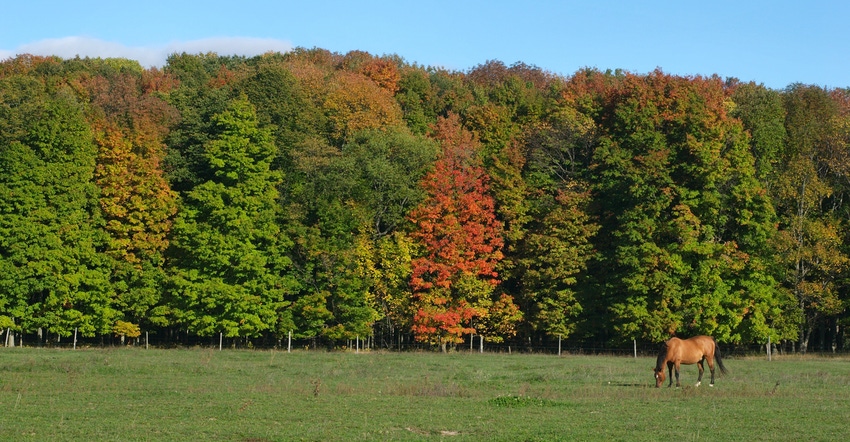September 15, 2021

Horses in two Minnesota counties have been confirmed to have two different equine diseases after they were euthanized, following deteriorating conditions.
An Itasca County mare was confirmed to have eastern equine encephalitis (EEE), which is spread to horses by mosquitoes. A Washington County mare tested positive for equine herpesvirus (EHV-1), which is easily spread between horses and can remain inactive for long periods of time.
“The similarity between these two equine diseases is, they can both take on a neurologic form and impact horses very severely, sometimes leading to death,” says Brian Hoefs, Minnesota Board of Animal Health senior veterinarian, of the equine program. “How the diseases are spread, how they’re prevented and how we respond to them are different. Because of the varied threat to the health of your horse, we strongly encourage routine checkups with your veterinarian.”
Eastern equine encephalitis horse
The first positive case of EEE in a Minnesota horse this year was a 6-year-old quarter horse mare from Itasca County that was euthanized Aug. 16 after showing symptoms of neurologic disease including loss of muscle control, inability to stand and eventually, convulsions. Samples were initially submitted for rabies and came back negative. Additional testing was ordered for neurologic diseases of horses, with only EEE-positive results returned. The horse had not left the farm since birth and had no history of vaccination against EEE. Nine additional horses reside on the farm and have been vaccinated for rabies, with appointments to vaccinate for EEE and other neurologic diseases scheduled.
Although thought to be rare, EEE can cause fatal infections in horses and people. The virus is primarily transmitted by mosquitos and birds, while horses are a “dead-end host,” unable to transmit the disease to other horses or people. In horses, EEE is fatal in more than 90% of cases. Clinical signs in horses can include fever, lethargy, not eating and walking aimlessly.
Even though people cannot contract the disease from horses, cases in horses are an indication that infected mosquitoes are in the area and can potentially infect humans.
Clinical illness and fatality in horses can be limited through vaccine and decreased exposure. MBAH encourages all horse owners to work with their veterinarians to get their horses vaccinated and get booster vaccines regularly, especially in an area where the disease has been confirmed.
Equine herpesvirus horse
An 18-year-old quarter horse mare from Washington County was confirmed positive on Sept. 2 for the neurologic form of EHV-1 known as equine herpesvirus myeloencephalopathy (EHM). On Aug. 26, the affected horse was reported to show mild loss of muscle control that steadily progressed overnight. The horse was euthanized the next day, and a second horse on the farm was euthanized by the owner the following week because it was displaying similar signs, though it was not tested.
Both horses had been on the farm for the 72 hours prior to clinical signs, which is the required traceback time period for MBAH to investigate potential exposure to other horses when EHV-1 neuropathogenic strain is detected. Because both horses attended horse shows held at the Washington County Fairgrounds on Aug. 14, a location in Lindstrom on Aug. 20, and a location in Hugo on Aug. 21, MBAH reached out to those locations to alert clients and attendees as an extra precaution.
The home farm of the positive horse is quarantined as part of the MBAH EHM control plan. The owner was told to collect and record temperatures every 12 hours on the 31 remaining horses on the property. Horses exhibiting clinical signs consistent with EHM or with temperatures of 102 degrees F or higher are required to be reported to MBAH. The quarantine remains in effect until 21 days after the last horse displays clinical signs, or a temperature of 102 or higher was obtained.
Due to the highly contagious nature of this disease, it is reportable to MBAH — which, in collaboration with Minnesota’s equine industry — developed and enforces an official control plan for EHM. MBAH works with veterinarians and horse owners to carry out testing and observation protocols defined in the control plan before quarantines can be released. This control plan can be found on the MBAH website.
The most common way for EHV-1 to spread is by direct horse-to-horse contact. Imported horses are required to have a negative Coggins test within the past 12 months. Biosecurity, including not sharing equipment, is currently the best defense against horses contracting EHM, because there is not a vaccine available to protect against the neuropathogenic strain of EHV-1. Horse owners and veterinarians can review biosecurity practices on the MBAH website.
Source: Minnesota Board of Animal Health, which is solely responsible for the information provided and is wholly owned by the source. Informa Business Media and all of its subsidiaries are not responsible for any of the content contained in this information asset.
You May Also Like




